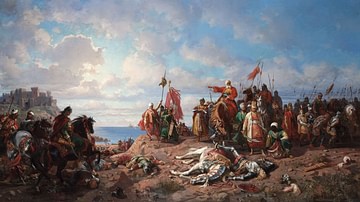Unravel the epic tales and tumultuous journey of the formidable Ottoman Empire, as it carved its path through history with a blend of might and diplomacy. Brace yourself for a riveting account that will transport you to an era where battles were fought, conquests were made, and empires rose and fell.
A Legacy Forged in Blood
Step into the annals of time as we delve into the early years of the Ottoman Empire. Born amidst chaos and uncertainty in 1299, this fledgling empire faced numerous challenges from rival powers seeking dominance over Anatolia. With their indomitable spirit fueled by ancestral wisdom passed down through generations, they embarked on a relentless quest to establish their sovereignty.
Their military prowess became legendary as they clashed with Byzantine forces at pivotal battles such as Bapheus (1302) and Pelekanon (1329). These encounters not only showcased their tactical brilliance but also highlighted their unwavering determination to expand their dominion beyond Anatolia’s borders.
An Unstoppable Force
As decades turned into centuries, the Ottoman Empire continued its meteoric rise under visionary leaders like Mehmed II – known famously as Mehmed the Conqueror. The capture of Constantinople in 1453 marked a turning point in world history; it symbolized both an end for one great empire and birthed another that would shape future civilizations.
This triumph was followed by further conquests across Europe, including Belgrade (1521), Rhodes (1522), Budapest (1541), Cyprus (1570), Crete (1669), among others. Each victory solidified their reputation as an unstoppable force capable of subjugating even the most fortified cities.
A Tapestry of Cultures
While military might played a pivotal role in their success, the Ottoman Empire was also renowned for its ability to assimilate diverse cultures and foster an environment of tolerance. This unique blend of influences from Anatolia, Persia, Arabia, and Europe created a rich tapestry that defined their empire’s identity.
Their capital city Istanbul (formerly Constantinople) stood as a testament to this cultural amalgamation. Mosques adorned with intricate Byzantine mosaics coexisted alongside grand palaces inspired by Persian architecture. The empire’s cosmopolitan nature attracted scholars, artists, and traders from across the globe – transforming it into a vibrant hub of intellectual exchange.
A Legacy Remembered
As we reflect upon the battles fought and conquests achieved by the Ottoman Empire between 1299-1683, we are reminded of both triumphs and tribulations. While they experienced setbacks like the Battle of Vienna (1683), which marked a turning point in their expansionist ambitions, their legacy endures through centuries.
The Ottoman Empire left an indelible mark on history – shaping political landscapes, influencing art forms such as calligraphy and miniature painting, introducing architectural marvels like domes and minarets that still grace skylines today. It is through understanding these complex narratives that we gain insight into our shared human journey filled with victories won against all odds.

